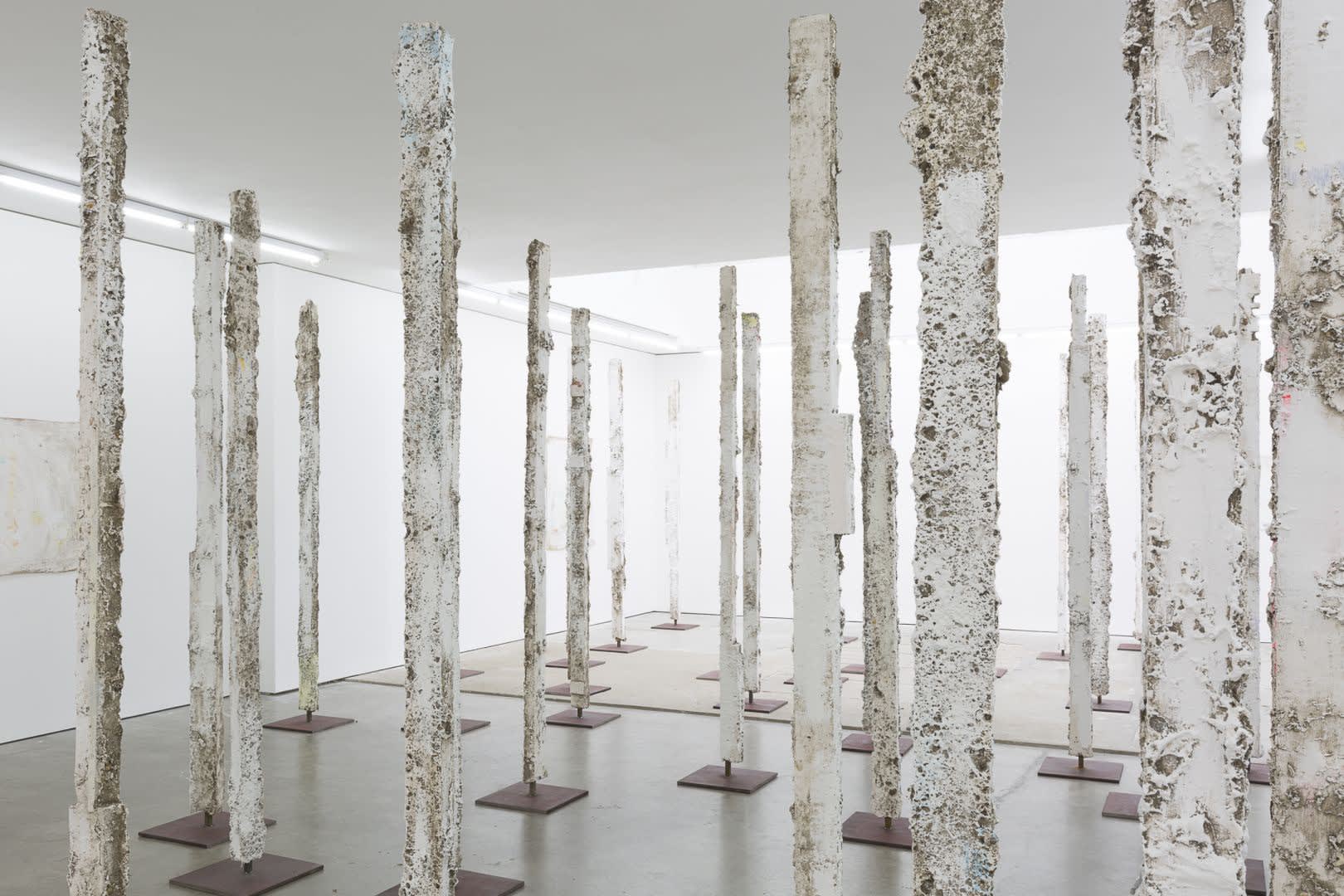08 August 2017 In her book, Quiet, Susan Cain declares that we live in a world of Extrovert Ideal. She describes our culture of personality's aspirations as gregarious, alpha and comfortable in the spotlight. Yet Cain also points out that some of the greatest ideas, art and inventions came from quiet and cerebral people who know 'how to tune into their interior worlds and the treasures to be found there'. At this point, Cain might well be describing Jodie Carey's quiet display at Edel Assanti.
50 gnarled ceramic sculptures, titled Earthcasts, stand tall in the gallery alongside four wall based, plastered canvases. They result from casting directly into the ground and therefore each one is uniquely formed subject to the organic life forms, temperature and moisture levels in the soil. With predominantly white surfaces, they create a hush in the space, inviting us to wander through the silent crowd of objects which bear resemblance to tree trunks, gaunt characters or a crowd of statues in museum storage.
As a starting point for Earthcasts, Carey used discarded wooden planks from the glorious Cast Courts at the Victoria & Albert Museum. Paying homage to European sculpture, the Courts are adorned with an astounding collection of plaster casts including a five meter version of Michelangelo's David (c.1856). The contrast is not lost between the dizzy heights of the origins of her materials and their humble end, buried in the ground to create plaster moulds.
Carey has been here before. Both her 2015 show and this one exploit the gallery's rear glass ceiling to create a soft, dreamy light over the work. Along with their cobbled together arrangement, it is this light which avoids them being ordered soldiers. The plaster casts seem to blissfully glow in the open canopy, equally memorials of their own making and an embodiment of solemn contemplation.

Jodie Carey, Stand, 2017, installation view at Edel Assanti.
Appearing at the intersection of what was and what will be, Carey's sculptural work corresponds with archaeological objects - once buried, now found and offering the possibility of further clarification. There is a residual presence but it is temporary and fraught. With barely any chance of replenishing, there is only further decay. Though her two dimensional wall pieces, while closely related, convey a slightly different scenario.
Hanging on the walls, plaster surfaces are washed across canvas, backed by hessian, giving a nod to sculpture making. Teensy, scratchy coloured marks, lines and v-shapes, are partly covered by stitching. The pastel marks are reminiscent of tailor's chalk, itself a material used to carve out the intentions of future work - folds, scissor cuts and where the stitches ought to be. Though Carey's are neither neat or linear. They're a scribbled approximate. Still, they give way to a sense of planning or storytelling, perhaps even a visual representation of verbal histories located somewhere between neolithic engraving, traditional weaving and domestic cross-stitch.
Walking around the gallery, around the tall, crumbling objects, elicits the feeling of something ancient. And along with her earlier vessels as well as work with blood, bones and ashes, I find myself thinking of the burial poles of Australian aboriginal Yolngu tribes. One of the oldest cultural burial practices, they decorated logs hollowed out by termites to bury the bones of their dead. Yet there is a quiet something about Earthcasts which halts them from being static memorials of the departed - the peculiar use of colour.
Throughout this small forest of what might be leafless birches, Carey has almost hidden discreet marks in paint and pencil. An unexpected smudge of pastel green. An abrupt little dash of fluorescent orange. Delightful to find, they suggest the artist's secret conversation with each cast or a coded track for a lover or a giggling child to follow. They link one object with the next, with the artist and with us, the viewer, introducing a sense of very much alive.
From their tactile surfaces which stretch beyond the human body, almost reaching the ceiling, to their minute coloured scribbles, Jodie Carey's vertical statues exemplify her commitment to the physical process of making art. Enlivened by our presence, they quietly avow to memory as a contemplative process of its own retrieval, rather than simply being an echo of what has passed. Edging close to the cerebral prompts of the traditional Japanese Shinto garden, Earthcasts conciliates the delicate balance between human fragility, the ephemeral monument and the nature of things.


